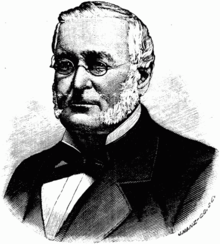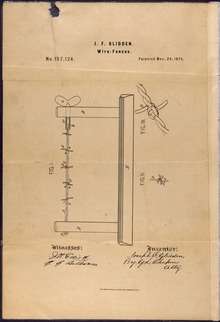Joseph Glidden
| Joseph Glidden | |
|---|---|
 Portrait in Prairie Farmer magazine, 1884 | |
| Born |
January 18, 1813 Charlestown, New Hampshire, U.S. |
| Died |
October 9, 1906 DeKalb, Illinois |
| Residence | Joseph F. Glidden House, DeKalb, Illinois, U.S. |
| Occupation | Businessman |
| Spouse(s) | Clarissa Foster (1837-1843) Lucinda Warne (1850-1895) |
| Children | Virgil Glidden, Homer Glidden, Elva Glidden[1] |
Joseph Glidden (1813-1906) was an American businessman. He was the inventor of the barbed wire.
Biography

Glidden was born in Charlestown, New Hampshire of English descent.[2] His family later moved to Clarendon, New York. In 1843, he moved to Illinois with his wife. She and their two sons died after the move, and Glidden married Lucinda Warne in 1851.
He created barbed wire by using a coffee mill to create the barbs. Joseph placed the barbs along a wire and then twisted another wire around it to keep the barbs in place. He received the patent for barbed wire in 1874 and was quickly embroiled in a legal battle over whether he actually invented it. He eventually won and created the Barb Fence Company in DeKalb, Illinois, making him extremely rich. By the time of his death in 1906, he was one of the richest men in America. The Dun & Bradstreet Collection, 1840-1895, MSS 791, LXIII, 130, Baker Library, Harvard, recorded his assets at one million dollars. This included the Glidden House Hotel; the DeKalb Chronicle; 3,000 acres (12 km²) of farm land in Illinois; 35,000 acres (1,360 km²) in Texas; and the Glidden Felt Pad Industry.

From 1852 to 1854, he served as Sheriff of DeKalb County. In 1851, 1861, 1862, 1869, 1870, 1871, 1872, and 1876 he served on the Board of Supervisors of the County. In 1867, he served on the Executive Committee of DeKalb County Agriculture and Mechanical Society's Seventh Annual Fall Fair, held September 25–28. In 1876, he was the Democratic nominee for Illinois State Senator. From 1861 to 1874, he served as a member of the Board of School Directors, and for 20 years paid the largest school tax of any citizen of the county. He was also one of the largest contributors to the erection of one of the churches. He was also Vice-President of the DeKalb National Bank, Director of the North Western Railroad, and owner of the DeKalb Rolling Mill.
To demonstrate the effectiveness of barbed wire, Glidden and his sales agent for the State of Texas, Henry B. Sanborn, developed the "Frying Pan Ranch" in Bushland, Potter County, Texas, in 1881. The wire was brought in by wagon from the railhead at Dodge City, Kansas, and the timbers were cut from Palo Duro Canyon and along the Canadian River Valley. A herd of 12,000 head of cattle was branded with the "Panhandle Brand", which the cowboys called "frying pan". The ranch proved the success of the wire and changed ranching. The ranch's headquarters were located at Tecovas Springs, six-miles northwest of Amarillo; the ranch's eastern border became Amarillo's Western Street.
Glidden, a former teacher, gave 63 acres (255,000 m²) of his homestead as a site for the Northern Illinois Normal School. The school opened on September 12, 1898, with 139 students and 16 members of the faculty. The school's name was changed to Northern Illinois University in 1957.
The town of Glidden, Iowa, is named in his honor.
In popular culture
The "barbed wire salesman" in Back to the Future Part III is either based on Joseph F. Glidden or John Warne Gates who was a pioneer promoter of barbed wire. He is played by Richard Dysart.
See also
Patents
- U.S. Patent 157,124 — Wire fences
References
- Clifton, Robert T., Barbs, Prongs, Points, Prickers, and Stickers. Norman: University of Oklahoma Press, 1970
- McCallum, Henry D., and Frances T., The Wire That Fenced the West. Norman: University of Oklahoma Press, 1965
- Unattributed, The Barbed-Wire Business in Prairie Farmer, Vol. 56: No. 1, January 5, 1884.
Notes
- ↑ http://www.gliddenhomestead.org/joseph_timeline.html
- ↑ Roberts, Gary Boyd, and David Curtis Dearborn (1998). Notable Kin: An Anthology of Columns First Published in the NEHGS Nexus, 1986-1995. Boston, Massachusetts: New England Historic Genealogical Society. p. 107. ISBN 978-0-936124-20-9.
—Van Dulken, Stephen (2001). Inventing the 19th century: 100 inventions that shaped the Victorian Age from Aspirin to the Zeppelin. New York City: New York University Press. p. 28. ISBN 978-0-8147-8810-3.